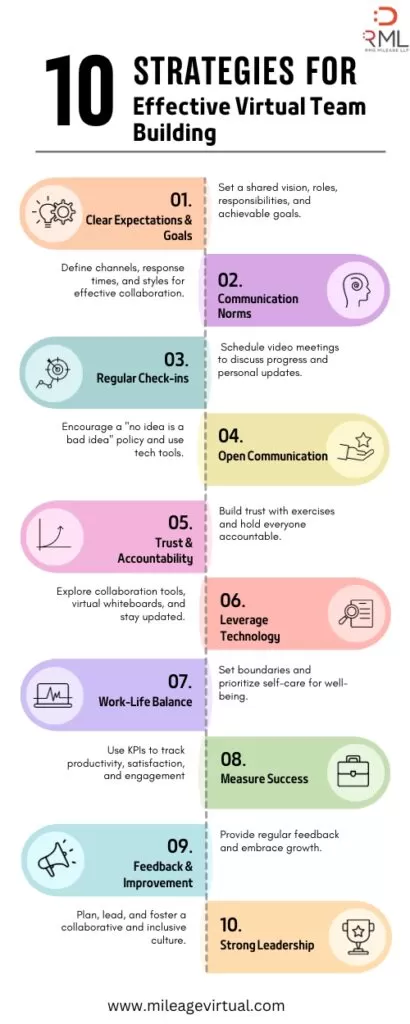
10 Strategies for Effective Virtual Team Building[Infographic included]
In today’s rapidly evolving business landscape, virtual teams have become an integral part of many organizations. With members spread across different locations and time zones, building effective virtual teams is crucial for achieving success. In this article, we will explore 10 strategies that can help you navigate the challenges of virtual team building and foster a strong and cohesive team.
The Challenges of Building a Virtual Team
One of the primary challenges of virtual team building is the lack of face-to-face interaction. Unlike traditional teams, virtual teams do not have the luxury of in-person meetings and social interactions, making it harder to establish trust and build strong relationships. Additionally, communication barriers, time zone differences, and cultural diversity can further complicate team dynamics.
Despite these challenges, organizations are finding innovative ways to overcome them and create successful virtual teams. One strategy is to utilize technology to facilitate communication and collaboration. Virtual team members can use video conferencing tools, instant messaging platforms, and project management software to stay connected and work together seamlessly.
Another important aspect of virtual team building is fostering a sense of trust and camaraderie among team members. This can be achieved through team-building activities specifically designed for virtual teams. For example, virtual icebreakers and team-building games can help team members get to know each other on a personal level and build rapport.
Furthermore, effective communication is crucial for virtual teams to thrive. Clear and concise communication is essential to ensure that everyone is on the same page and understands their roles and responsibilities. Team leaders should establish regular check-ins and provide opportunities for team members to ask questions and seek clarification.
Time zone differences can pose a significant challenge for virtual teams, but they can also be turned into an advantage. By leveraging different time zones, virtual teams can achieve round-the-clock productivity. For example, a team in Asia can work on a project during their daytime, and then pass it on to a team in Europe or the Americas, who can continue working on it while the first team is offline. This allows for continuous progress and faster turnaround times.
Cultural diversity within virtual teams can bring a wealth of perspectives and ideas, but it can also lead to misunderstandings and conflicts. To overcome this challenge, organizations should promote cultural sensitivity and provide cultural awareness training to team members. By fostering an inclusive and respectful environment, virtual teams can harness the power of diversity and achieve better outcomes.
In conclusion, virtual team building is essential in today’s business environment. While it presents unique challenges, organizations can overcome them by leveraging technology, fostering trust and communication, capitalizing on time zone differences, and promoting cultural sensitivity. By investing in virtual team building, companies can unlock the full potential of their global talent pool and drive success in the digital age.
Laying the Foundation for Your Virtual Team
Setting Clear Expectations and Goals
Before diving into virtual team building, it is essential to define clear expectations and goals. Clearly communicate the team’s purpose, roles, and responsibilities to ensure everyone is on the same page. This will help establish a shared vision and create a sense of direction.
When setting expectations, it is important to consider each team member’s strengths and weaknesses. By understanding their individual capabilities, you can assign tasks that align with their skills, maximizing productivity and efficiency. Additionally, clearly defining goals will provide the team with a sense of purpose and motivate them to work towards a common objective.
Furthermore, it is crucial to establish a timeline for achieving these goals. Breaking down larger objectives into smaller, manageable tasks can help track progress and ensure that the team stays on track. Regularly reviewing and updating these goals will allow for adjustments and improvements as needed.
Establishing Communication Norms
Communication is the lifeline of any team, especially for virtual teams. Establishing communication norms is crucial to ensure effective collaboration. Define preferred communication channels, response times, and etiquettes to minimize misunderstandings and facilitate seamless information exchange. Encourage open and transparent communication to foster a supportive team culture.

In addition to defining communication norms, it is important to consider the diverse communication styles and preferences of team members. Some individuals may prefer written communication, while others may thrive in video conferences or phone calls. By accommodating different communication preferences, you can create an inclusive environment where everyone feels comfortable expressing their ideas and opinions.
Moreover, establishing regular check-ins and team meetings can help maintain a strong connection among team members. These meetings provide an opportunity to discuss progress, address any challenges, and celebrate achievements. By fostering a sense of camaraderie and collaboration, virtual teams can overcome the physical distance and work together effectively.
Lastly, it is essential to encourage active listening within the team. By actively listening to one another, team members can better understand different perspectives and foster a culture of respect and empathy. This not only enhances communication but also strengthens relationships within the team.
Strategies for Virtual Team Building
Implementing Regular Check-ins
Regular check-ins are essential for virtual team building. Schedule recurring meetings to discuss progress, address concerns, and ensure alignment. These check-ins provide an opportunity to connect, share updates, and offer support. Consider using video conferencing to simulate face-to-face interactions and build stronger relationships.
During these regular check-ins, team members can not only discuss work-related matters but also share personal updates. This helps create a sense of camaraderie and allows team members to connect on a more personal level. Sharing stories about hobbies, interests, or recent experiences can foster a stronger bond among virtual team members.
Furthermore, these check-ins can be used as a platform to celebrate achievements and milestones. Recognizing and acknowledging the hard work and accomplishments of team members can boost morale and motivation within the virtual team. It also creates a positive and supportive environment where everyone feels valued and appreciated.
Encouraging Open Communication
In virtual teams, fostering open communication is crucial for transparency and collaboration. Encourage team members to share their ideas, opinions, and feedback freely. Create a safe and inclusive environment where everyone feels comfortable speaking up.
One way to encourage open communication is by implementing a “no idea is a bad idea” policy. This means that every team member’s input is valued and respected, regardless of how unconventional or different it may be. By promoting this mindset, virtual teams can tap into the diverse perspectives and experiences of their members, leading to more innovative and creative solutions.
Additionally, leverage technology tools such as instant messaging and online collaboration platforms to facilitate real-time communication. These tools allow team members to engage in quick discussions, ask questions, and provide updates without the need for lengthy email threads. By utilizing these communication channels effectively, virtual teams can maintain a constant flow of information and stay connected despite physical distance.
Fostering a Culture of Trust and Accountability
Trust is the foundation of any successful team, and virtual teams are no exception. Building trust within a virtual team requires consistent effort. Encourage trust-building activities, such as team-building exercises, icebreaker games, and virtual coffee chats.
Team-building exercises can be tailored to the virtual environment and can include activities such as virtual scavenger hunts, online escape rooms, or collaborative problem-solving challenges. These activities not only promote trust but also encourage teamwork and collaboration.
Promote accountability by setting clear expectations, recognizing achievements, and addressing any performance issues promptly. Clearly define roles and responsibilities within the virtual team, ensuring that everyone understands their individual contributions to the overall team goals. Regularly communicate progress and milestones, allowing team members to track their own performance and hold themselves accountable.
Leveraging Technology for Team Collaboration

Technology plays a vital role in virtual team building. Explore collaboration tools that facilitate seamless communication, file sharing, and project management. Choose platforms that allow team members to access information easily, track progress, and collaborate in real-time.
Virtual whiteboards can be a valuable tool for brainstorming and visualizing ideas. These digital platforms allow team members to contribute their thoughts and ideas simultaneously, fostering collaboration and creativity. They can also be used to track project timelines, assign tasks, and monitor progress.
Regularly evaluate and optimize the technology stack to ensure it meets the team’s evolving needs. Stay updated with the latest advancements in virtual collaboration tools and consider implementing new features or platforms that can enhance team productivity and efficiency.
Promoting Work-Life Balance in a Virtual Environment
Virtual teams often face challenges in maintaining a healthy work-life balance due to the blurred boundaries between professional and personal life. Encourage team members to set boundaries, take breaks, and prioritize self-care.
One way to promote work-life balance is by establishing clear expectations regarding working hours and availability. Encourage team members to communicate their preferred working schedule and respect each other’s personal time. This can help prevent burnout and ensure that team members have dedicated time for their personal lives.
Additionally, encourage team members to take regular breaks throughout the day. Encourage activities such as stretching, walking, or engaging in hobbies to refresh the mind and prevent fatigue. By promoting a healthy work-life balance, virtual teams can maintain high levels of productivity and well-being.
Measuring the Success of Your Virtual Team Building Efforts
Key Performance Indicators for Virtual Teams
Tracking the success of your virtual team building efforts is essential to evaluate their impact and make data-driven improvements. Define key performance indicators (KPIs) relevant to your team’s goals, such as productivity metrics, customer satisfaction ratings, and employee engagement surveys. Regularly measure these KPIs and adjust your strategies accordingly.
Feedback and Continuous Improvement in Virtual Teams
Feedback is crucial for continuous improvement in virtual teams. Provide regular feedback to team members to recognize their strengths and offer guidance for growth. Encourage a culture of feedback exchange where team members can provide constructive input to one another. Embrace a growth mindset and be open to adapting your virtual team-building strategies based on feedback.
Building effective virtual teams requires careful planning, strong leadership, and a commitment to fostering a collaborative and inclusive culture. By understanding the importance of virtual team building, laying the right foundation, and implementing effective strategies, you can overcome the challenges and unlock the full potential of your virtual team.

